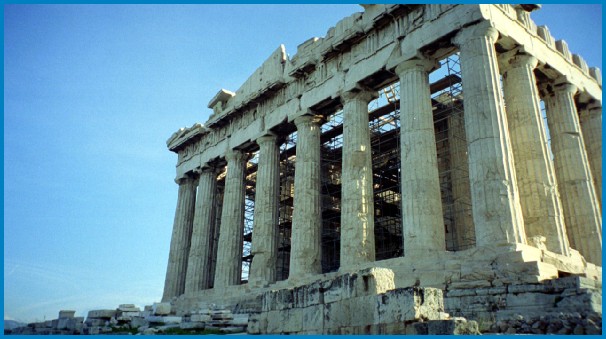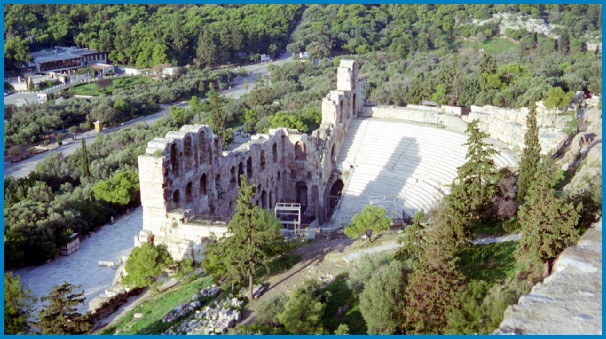
Here's a view looking back through the entrance of the Acropolis.

And here's the picture you've all been waiting for, just like the others you've seen a million times, in a million books, and in every travel pamphlet for Greece...the Parthenon:

The whole top of the Acropolis is under construction. Apparently, it's frequently being worked on. At this point though, it was under heavy construction, in preparation for the 2004 Olympics. Did I mention that the most important museum in Athens was also closed to get ready for the Olympics? It closed at the end of September and won't open for a year and a half or so. New rule -- don't visit countries getting ready for the Olympics.

Obligatory shot of me in front of the Parthenon:

The Erechtheion was the main sanctuary on the Acropolis (the Parthenon was just a showpiece). It was built on the spot where Poseidon struck the ground to bring forth a spring and where Athena produced the olive tree during their contest to see who would be the patron deity of Athens -- guess who won.

The southern portico is held up by 6 Caryatids, statues of women. They're called that because the models came from Karyai.

More reconstruction work inside the Erechtheion.

There are two theatres on the southern slope of the Acropolis. The Theatre of Dionysos and the Theatre of Herodes Atticus. The latter was reconstructed in the 1950s and it's used during the Athens Festival.


And, of course, the Acropolis, like all other self-respecting archeological sites, has lots piles of leftover pieces. This picture shows just a few of them:

In the afternoon, we visited the Roman Agora, the Ancient Agora, and the Goulandris Museum of Cycladic and Ancient Greek Art.
The Ancient Agora had a cool, two-story building known as the Stoa of
Attalos. It was rebuilt in the 1950s. The top story is supported by
Ionic columns and the bottom story by Doric columns.
I still really like the Stoa's colonnade.
In the museum, there was a stone with lots of slots. They used to
place strips of metal into the slots. Each strip had a person's name
on it. Then, they dropped white and black balls onto the strips
randomly. If a name got a white ball, it was accepted. If it got a
black ball, it was rejected. This was was used to select council
members to represent each tribe.
On a cool little hill sits the Temple Of Hephaestus.



